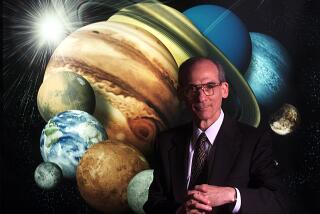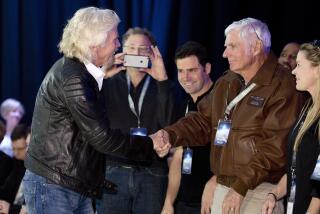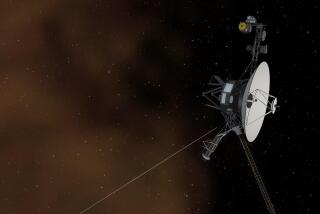Voyager 1 set to leave solar system after 35 years
In 1977, Jimmy Carter moved into the White House, “Star Wars” and “Saturday Night Fever” premiered in theaters and the Voyager 1 and 2 spacecraft launched from Florida’s Cape Canaveral to explore the outer solar system.
In the years since, there have been five more presidents and five more “Star Wars” movies; disco has given way to punk, grunge and rap; and the Voyagers have flown billions of miles past Jupiter, Saturn, Uranus and Neptune.
Their explorations aren’t over yet.
As scientists at the Jet Propulsion Laboratory in La Cañada Flintridge marked the mission’s 35th anniversary this week, they marveled that Voyager 1 was poised to leave the solar system — crossing the so-called heliopause and entering the vastness of interstellar space.
When that happens, Voyager 1 will become the first spacecraft launched from Earth to “leave the bubble,” said former JPL Director Edward Stone, who still serves as a project scientist on the mission as a member of Caltech’s Space Radiation Lab.
Plans for Voyager hatched in 1965, when a Caltech graduate student working at JPL realized that a space probe launched in 1977 could follow a trajectory past all four giant planets, Stone explained during a public lecture at JPL on Tuesday.
Both Voyager craft reached Jupiter in 1979, taking pictures that indicated its distinctive Great Red Spot was in fact a hurricane. Studying the planet’s moons, the Voyagers revealed that Io was volcanically active and that Europa was covered with ice. The two spacecraft moved on to Saturn in 1980 and 1981 and got a close look at the planet’s moons and trademark rings.
After Saturn, Voyager 1 zoomed away from the plane of the solar system, leaving the planets behind.
Voyager 2, which was on a slower trajectory, flew past Uranus in 1986 and surprised astronomers by discovering that the planet’s magnetic poles lay near its equator. It approached Neptune in 1989 and revealed that the most distant planet had the fastest winds in the solar system, even though it received relatively little energy from the sun.
“Time after time, Voyager taught us the solar system was more diverse than we could have imagined,” Stone told the JPL audience.
The mission also became a cultural touchstone. Both vessels carry copies of the “Voyager Golden Record,” a sort of message in a bottle intended to instruct alien civilizations — should any encounter either craft — about humans and our lives on Earth.
And in February 1990, while 6 billion miles from Earth, Voyager 1 turned its cameras to take a family portrait of the solar system. Part of that image was the famous “Pale Blue Dot” photograph, which depicted our planet as a tiny blip in the heavens.
“That’s home. That’s us,” astronomer Carl Sagan wrote of the picture. “On it everyone you love, everyone you know, everyone you ever heard of, every human being who ever was, lived out their lives.”
Voyager 1 is now 11.3 billion miles from the sun. It takes 17 hours for a signal from the spacecraft to reach Earth, Stone said.
Scientists don’t know exactly where the edge of the solar system is, but they know Voyager 1 can’t be too far away.
The solar system exists in a bubble of solar wind known as the heliosphere. As the fast-moving, charged particles that make up the solar wind travel farther and farther from the sun, they lose strength.
The boundary where the solar wind slows to subsonic speeds is called the termination shock. The line where it stops altogether, butting up against the surrounding gases of interstellar space and forming the outside of the bubble, is called the heliopause. The region in between is called the heliosheath.
As Voyager 1 makes its way through the heliosheath, it’s collecting data that’s challenging scientists’ views of this distant boundary.
Scientists had thought the solar wind in the heliosheath would slow and then change direction from an outward to an upward flow as it bumped up against the heliopause. Instead, Voyager 1 found that the solar wind slowed and then seemed to stall out altogether.
Robert Decker, a space scientist at the Johns Hopkins University Applied Physics Laboratory in Laurel, Md., said it appeared the solar wind in the heliosheath was passing through some kind of transition region. He was part of a team that described the findings this week in the journal Nature.
“The mystery now is, where is the plasma flow going?” Decker said. “We don’t know, and we don’t know how to answer the question.”
Decker and his coauthors wrote that their discovery, generated using data collected through February 2012, indicated that Voyager 1 was “not at present close to the heliopause.”
More recent observations, however, have indicated the spacecraft may be nearing the boundary after all, Decker said in an interview.
Voyager 1’s instruments have calculated that low-energy particles that can be used to estimate movements of the solar wind have been dropping in intensity from time to time. Meanwhile, the intensity of incoming cosmic rays from interstellar space has increased.
That is a hint of what scientists expect to see at the heliopause, Decker said.
At his talk this week at JPL, Stone plotted dramatic graphs of the particle fluctuations that occurred in July. The audience gasped each time the data curves spiked.
“There is some kind of connection between where Voyager is and the outside,” Stone said, though he cautioned that no one knew whether the big event was days, months, or even years away.
Decker said that once the intensity of particles from the solar wind stayed low, the intensity of particles from interstellar wind stayed high, and the telltale changes in magnetic fields took hold, the scientific teams working on Voyager 1 would have to call a powwow.
“That’s when we’ll get together and decide: Are we there yet?” he said.
He predicted it would happen before the end of the year.







